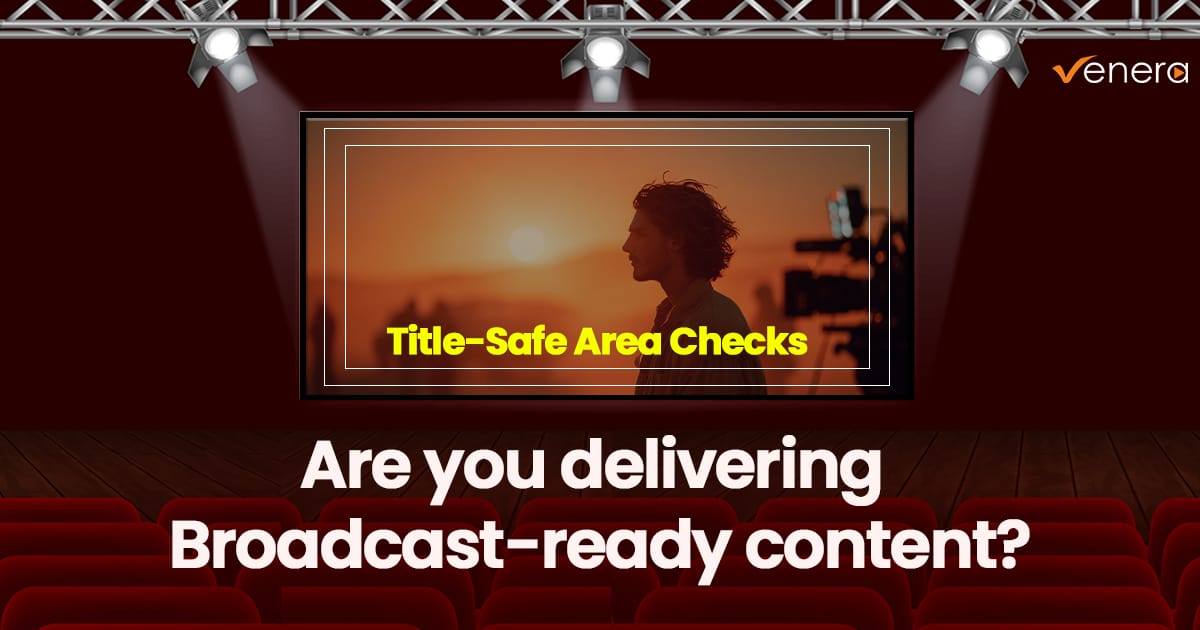While delivering your content for broadcast, do you ensure titles and captions fall within the title-safe area?
If not, even your most stunning video production can be rejected by the broadcasters. If your titles, graphics or captions carrying important information are partially or completely cut off while viewing on different screens, it looks unprofessional and may disappoint your audience.
That’s why a proper title-safe area check is integral to broadcast-readiness.
Today’s post will shed light on what the title-safe area is, why it matters, and how Venera’s QC tools help media professionals deliver flawless, compliant content every single time.
What is a Title-safe area?
The title-safe area is a specified boundary inside a video frame that makes sure all important text elements—such as titles, subtitles, captions, graphics, credits, and logo—are completely visible on all types of display screens.
In the past, overscan caused television screens and broadcast monitors to crop the outer edges of the frame. While modern digital displays and streaming platforms don’t have this overscan issue, broadcasters still mandate compliance with safe-area requirements to guarantee consistent viewing across multiple devices and platforms.
They have defined two safe zones to avoid losing critical information:
- Action-Safe Area: It is the inner 90% area of the frame where the main visual action of the scene is visible, even if the edges of the frame are cropped.
- Title-Safe Area: The inner 80% of the screen where all the text should remain fully visible.
Why is Title-Safe Important in Video QC?
Delivering content without ensuring it meets title-safe compliance can have serious consequences. Here’s why it matters:
- Preserves Viewer Experience
If captions, credits, or lower-third graphics appear cropped or cut off, it disrupts the viewing experience and reduces clarity. This is particularly important as many viewers depend on subtitles and closed captions.
- Meets Broadcast Standards
Safe-area checks are one of the stringent technical requirements for the majority of broadcasters and OTT platforms. Delays, rejections, and expensive rework may arise from noncompliance.
- Protects Brand reputation
Imagine the title graphic on some screens being partially obscured when a high-budget production is released. It can harm the reputation of the content creator or distributor in addition to giving the impression of being unprofessional.
- Ensures Accessibility
A cropped caption line makes content inaccessible to many viewers, undermining inclusivity efforts.
- Saves Time and Cost
The cost of re-edits may go up if title-safe violations are discovered late in the workflow. Automated quality control guarantees that issues are identified early, saving both time and money.
The Role of Automated QC in Title-Safe Checks
Previously, the content was manually examined for title-safe compliance by editors and QC operators. But it took a lot of time and was prone to mistakes. Manual checks are no longer feasible due to the large-scale, multi-format, multi-device content delivery requirements of today.
This is where automated file-based QC systems like Quasar (cloud-native QC) and Pulsar (on-premise QC), come in. By integrating title-safe checks into the QC workflow, content creators and distributors can ensure broadcast-readiness with speed, precision, and scalability.
Here’s how these solutions address title-safe checks:
- Automated Title-Safe Detection
These QC tools automatically scan video files to detect whether titles, captions, and graphics lie within the defined safe-area boundaries. Any violations are flagged instantly. - Flexible Safe-Area Settings
Different broadcasters and platforms have varying title-safe requirements. Automated solutions allow you to configure custom safe-area margins to match the exact specifications of each destination platform. - Detailed Reporting
Violations are logged with timecodes and visual thumbnails so operators can quickly pinpoint and resolve issues. This streamlines the correction process and eliminates guesswork. - Cloud-Native Efficiency
With the cloud based automated QC solutions, safe-area checks can be performed at scale in the cloud, making it easier to process large volumes of content quickly and collaboratively. - Seamless Integration
Venera’s QC solutions integrate smoothly into existing media workflows, whether on-premise or in the cloud, ensuring title-safe checks are not an afterthought but a built-in safeguard.
Conclusion
In the fast-paced world of digital media, ensuring content is broadcast-ready isn’t optional—it’s essential. The title-safe area is one of the many necessary quality control checks that is essential to maintaining the viewing experience, adhering to broadcaster requirements, and protecting a brand’s reputation.
Manual checks by themselves are no longer adequate. Media professionals can confidently deliver flawless content, automate title-safe checks, and remove errors with sophisticated file-based quality control systems.
So, the next time you prepare content for delivery, ask yourself: Have you ensured your titles are safe?































